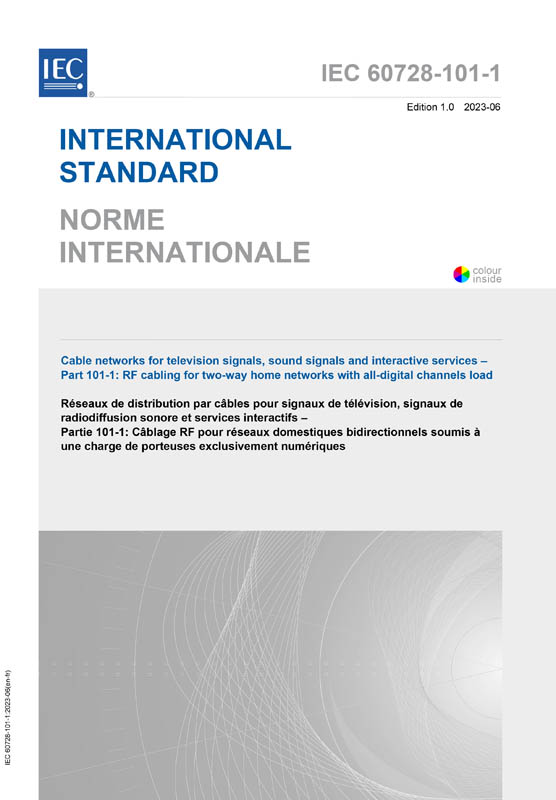IEC 60728-101-1:2023
Cable networks for television signals, sound signals and interactive services - Part 101-1: RF cabling for two-way home networks with all-digital channels load
Ausgabedatum:
2023-06
Edition:
1.0
Sprache: EN-FR - zweisprachig englisch/französisch
Seitenzahl: 142 VDE-Artnr.: 251922
IEC 60728-101-1:2023 provides the requirements and describes the implementation guidelines of RF cabling for two-way home networks; it is applicable to any home network that distributes signals provided by CATV/MATV/SMATV cable networks (including individual receiving systems) having a coaxial cable output. It is also applicable to home networks where some part of the distribution network uses wireless links, for example in place of the receiver cord.
This part of IEC 60728 is therefore applicable to RF cabling for two-way home networks with wired cords or wireless links inside a room and primarily intended for television and sound signals operating between about 5 MHz and 3 300 MHz. The frequency range is extended to 6 000 MHz for distribution techniques that replace wired cords with a wireless two-way communication inside a room (or a small number of adjacent rooms) that uses the 5 GHz to 6 GHz band.
In a building divided into apartment blocks, the distribution of the signals inside the home starts from the home network interface (HNI) up to the system outlet or terminal input. The requirements at the system outlet are given in IEC 60728-101:2016, Clause 5 and the requirements at the HNI are given in IEC 60728-101:2016, Clause 7. In Clause 5 of this document, additional requirements are given.
This document deals with various possibilities to distribute signals in a home network, using coaxial cables, balanced pair cables, fibre optic cables (glass or plastic) and also wireless links inside a room (or a small number of adjacent rooms) to replace wired cords.
This document gives references to basic methods of measurement of the operational characteristics of the home cable network in order to assess its performance.
All requirements refer to the performance limits, which are obtained between the input(s) at the home network interface (HNI) and the output at any system outlet when terminated in a resistance equal to the nominal load impedance of the system, unless otherwise specified. Where system outlets are not used, the above applies to the terminal input.
The present document also provides limits for the accumulation of degradations if the home network is subdivided into a number of parts, using different transmission media (e.g. coaxial cabling, balanced cabling, optical cabling, wireless links).
Clause 5 defines the performance limits measured at system outlet or terminal input for an unimpaired (ideal) test signal applied at the HNI. Under normal operating conditions for any digital channel and meeting these limits, the cumulative effect of the impairment of any single parameter at the HNI and that due to the home network produces signals not worse than the requirements given in IEC 60728-101-2. For digitally modulated signals, the quality requirement is a QEF (quasi error-free) reception.
This document describes the physical layer connection for home networks. Description of protocols required for layer 2 and higher layers is out of the scope of this document. Logical connections between devices within the home network are therefore not always guaranteed.
This International Standard is to be used in conjunction with IEC 60728-101:2016.


